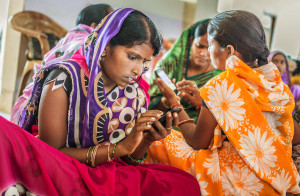Illustrative Example: Determine Activities and Interventions (Step 5)
SBCC approaches, activities and illustrative examples are presented here as potentially appropriate choices for communicating with audiences about breastfeeding. These suggestions are a starting point—you might think of others that fit your situation well. Include in your strategy only the approaches and activities you have the resources and experience to carry out successfully. Close collaboration with communication and creative professionals can help ensure that design and execution are innovative and compelling.
Please note that FBO messaging about breastfeeding should be consistent with national and local efforts. It can be integrated into essential newborn care, IYCF, MCH, and SBCC efforts.
Reviews from many successful countries have shown that success on breastfeeding can be achieved by:
- Doing all of the right things (comprehensive, evidence-based package, based on assessment of needs and situation)
- At all levels (national, health system, community, communication)
- In the right way (applying best practices, using effective strategies, providing appropriate training & supervision)
- For everyone (national scale and ensuring equity)
- All the time (sustained, ongoing implementation, fully institutionalized)
Some FBOs might need substantial support to plan and implement such a comprehensive program, so it is important to find out what others are doing (or willing and able to do) to increase optimal breastfeeding and to collaborate and coordinate with them when possible. For example, if a larger NGO or the MOH is implementing a mass media campaign, the FBO might:
- Implement peer support through mothers’ groups, prayer groups or other supportive groups,
- Use religious services to deliver breastfeeding messages that reinforce the mass media effort,
- Train and send experienced mothers to maternity wards to support women just learning to breastfeed,
- Organize community dialogues on the importance of optimal breastfeeding and risks of not breastfeeding,
- Organize workshops or one-on-one sessions where women learn how to practice optimal breastfeeding, including correct positioning and active feeding, and
- Organize workshops where women learn what, when, and how to prepare appropriate foods for complementary feeding.
If the FBO has a health facility, it should also institute the Baby Friendly Hospital Initiative (BFHI) and ensure appropriate staff are trained and doing what they are supposed to do to promote and facilitate early and exclusive breastfeeding. FBO health facilities can also ensure breastfeeding counseling and materials are provided to anyone seeking MCH services. Key breastfeeding interventions proven to be effective include:
- Legislation to protect breastfeeding
- Institutionalizing the BFHI/10 Steps
- Counseling & support through primary health care (integrated IYCF counseling)
- Counseling & support by trained community cadres (integrated IYCF counseling)
- Mother to mother support groups in the community
- Implementation of an evidence-based comprehensive communication strategy
Depending on country context, it may also be important to have interventions that address policy and practice (including pre-service education), supply, and monitoring.
Examples of breastfeeding interventions, materials, and programs can be found in Resources.
Mass Media
| INTERVENTION AREA | ILLUSTRATIVE ACTIVITIES | PURPOSE | INTENDED AUDIENCE |
| Local mass media |
(A successful TV spot in Viet Nam showed babies talking about the benefits of breastfeeding and one baby asking its mother to breastfeed only).
|
Increase awareness and knowledge of benefitsIncrease acceptability of optimal breastfeeding practicesDepict role models practicing desired behaviors; stimulate social dialogue about everyone’s role in protecting maternal and child healthAnswer listener questions to further dispel myths and provide accurate informationShift social norms around breastfeeding | Pregnant women/new mothersGrandmothers and other caregiversFathersFaith communitiesBroader communitiesSpots will also reach some health providers, faith leaders, and political leaders |
| Print media |
|
Increase awareness about breastfeeding benefits and formula/mixed feeding risksRemind audiences of key messages | Pregnant women/new mothersFathersFaith communities |
| Digital media and mHealth |
|
Increase awarenessStimulate social dialogueIncrease knowledge and skills | Pregnant women/new mothersFathersFaith communities |
Community-Based Services, Outreach and Community Approaches
| INTERVENTION AREA | ILLUSTRATIVE ACTIVITIES | PURPOSE | INTENDED AUDIENCE |
| Traditional birth attendant (TBA) outreach |
|
Improve knowledge and skillsImprove linkages with faith community and health systemAcknowledge TBA value | TBAs |
| Community Health Worker (CHW) outreach |
|
Improve knowledge and skillsProvide peer-supported learning opportunitiesEnsure quality counseling, education and referralPromote optimal breastfeeding practice as the new norm Provide incentives | CHWs |
| Community approaches |
|
Encourage social dialogue on relevant breastfeeding topicsIncrease social support for optimal breastfeeding practicesDecrease social support for mixed and formula feedingCreate/improve environment for cultural shiftIncrease breastfeeding prevalence and duration | Pregnant womenGrandmothersFathersCommunities TBAs |
| Peer Educators/ Champions |
|
Encourage social dialogue on preventing neonatal deathsIncrease social support for optimal breastfeeding practices | WomenGrandmothers and other caregiversFathers and communities |
Structural
| INTERVENTION AREA | ILLUSTRATIVE ACTIVITIES | PURPOSE | INTENDED AUDIENCE |
| Policy and guidelines |
|
Increase knowledgeEnsure appropriate guidelinesEnsure practice matches policy | Health district and facility decision-makers and implementers |
| Pre-service, in-service, on-the-job, and refresher training |
|
Increase awareness and practice | Health providers |
| Digital/distance learning |
|
Increase and refresh knowledge and skills | ANC providers Skilled birth attendants Supervisors of CHWs |
| Other continuing education |
|
Increase awareness and improve practice | Professional associations for health providers |


